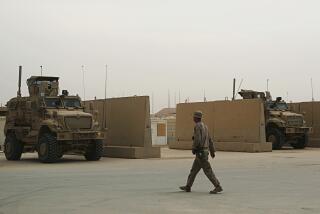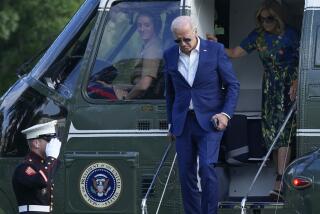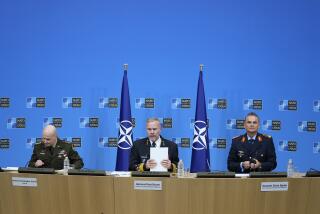Bosnia Pact Would Bring U.S. Nearer to Risky Deployment : Military: Troops set to go to Balkans face prospect of snipers and snow. White House expects to get flak on home front.
WASHINGTON — The prospect that a peace accord for Bosnia may be initialed in Ohio today has brought the Clinton Administration to the brink of an action laden with both military and political risks: the deployment of nearly 25,000 U.S. troops to that dangerous country as part of a NATO peacekeeping force.
Although President Clinton has pledged that he will not send any U.S. troops until an accord is actually signed--about two weeks from its initialing--planning for the mission is all but complete, and the units are ready to go.
In Bosnia-Herzegovina, the troops will face dangers ranging from snipers to snow. And on the home front, many congressional Republicans want to derail Clinton’s plan legislatively.
Pentagon officials say U.S. and allied troops would operate in Bosnia under the North Atlantic Treaty Organization’s rules of engagement, which essentially allow them to fire at anything that appears threatening. They would not have to wait until an adversary fires first--something that has hobbled the United Nations mission in Bosnia.
The operation would be fully under NATO control, with no need for allied officials to wait for U.N. approval before mounting any operation, as they have done with NATO-led air strikes in Bosnia.
U.S. and NATO officials say the primary mission of the peacekeeping force would be to separate the forces of the three major warring factions in Bosnia--the Muslims, Croats and Serbs--and keep them apart by enforcing steadily widening demilitarized zones between them.
It would also help to protect supply convoys and humanitarian aid workers and to patrol Bosnia’s borders in the event of surprise attacks. In addition, the United States would help provide intelligence, logistics and air cover.
Just exactly how long the troops would be required, however, is uncertain.
Pentagon officials say they expect an advance contingent of about 1,600 U.S. and NATO military specialists to be sent to Bosnia within a few days of initialing of an accord to set up headquarters and communications and begin repairing roads and bridges.
If a final agreement is signed, the United States and its NATO allies would begin pouring about 60,000 heavily armed ground troops into the region, including what is estimated at 23,000 Americans.
The NATO-led Implementation Force--or IFOR, as the peacekeeping contingent would be known--is expected to be fully in place within 45 to 60 days after a peace accord is signed.
NATO military planners have divided Bosnia into zones of responsibility, with U.S., British and French forces each heading one. Troops from non-NATO countries, including Russia, would be folded into one of the three sectors.
U.S. forces would be assigned to the area around the U.N.-designated “safe area” of Tuzla in eastern Bosnia, British troops to the west and French to the southern part of the country, including the capital, Sarajevo.
About 8,000 of the British and French troops already are in the country as part of the 12,600-member rapid-reaction force that the Europeans sent in this summer to help protect U.N. peacekeepers. They would now shift to NATO control.
The U.S. detachment would be drawn primarily from the European-based 1st Armored Division, which has been training for months in Germany. Air Force and Navy jets would provide air cover, and Marines would stand by offshore.
The Pentagon would also call up about 3,000 reservists in specialty areas such as military police and civil affairs. The Air Force would use reservists to fly transport planes involved in airlift operations.
As even supporters of the planned deployment concede, the mission could prove both difficult and dangerous.
The most immediate challenge is one of logistics--getting the thousands of U.S. and allied troops, and their heavy equipment such as tanks and Bradley fighting vehicles, into the country and keeping them supplied.
Although some would arrive by air, many would come by rail across Germany and Central Europe. And some would be carried by barge on the Danube River to staging bases in Hungary and Croatia.
Once they are in Bosnia, the troops would face possible snipers from dozens of rogue paramilitary groups on all three sides that are dissatisfied with the terms of the peace accord.
U.S. officials are particularly worried about Muslim forces from Afghanistan and Iraq, who have been operating independently from the Muslim-led but secular Bosnian government. The Administration has demanded that all of them leave before U.S. troops arrive, but it is not clear that the Bosnian government has the clout to send them home.
Then there is the threat from land mines, particularly when there is a cover of snow. Intelligence estimates show there now are about 6 million unexploded mines in Bosnia, with no reliable maps of where they may lie.
Pentagon planners say NATO intends to use sophisticated sensors and pilotless spy drones to help keep tabs on the combatants’ troop movements and equipment, but they add that the risks still are formidable.
The NATO contingent would also be impeded by the fierce Bosnian winter--which has already begun--making military operations far more difficult. Some roads are already impassable. Fog is hindering air operations.
Finally, the peacekeepers would be hampered by the damage to Bosnia’s infrastructure from almost four years of war. Many key bridges and airfields badly need repair. Secondary roads are in poor shape.
NATO planners worry about the prospect of driving heavy U.S. M1-A1 tanks over narrow, two-lane roads and mountain passes. And Bosnia’s port facilities are limited, making resupplying by sea more difficult.
Defense Secretary William J. Perry has said the troops would act aggressively whenever challenged by opposing forces or paramilitary units. NATO forces, he said, would be “the meanest dog in town.”
Gen. George A. Joulwan, a U.S. Army general who also serves as NATO’s supreme commander, has been assigned to direct the overall operation from NATO headquarters in Brussels.
The tactical commander of the NATO peacekeeping force would be U.S. Navy Adm. Leighton W. Smith, commander of NATO forces in Southern Europe, who would shuttle between headquarters in Sarajevo and Zagreb, Croatia’s capital.
But officials concede that all the heavy armor and aggressive rules of engagement would not be sufficient to enable the troops to avoid casualties, particularly from snipers and ambushes by paramilitary units.
Although Administration officials would not say how many U.S. troops they expect to be killed or wounded, outsiders say it is possible that the number could exceed the totals of the 1991 Persian Gulf War, in which 146 Americans were killed in action and 354 were wounded.
U.S. officials say Clinton plans to spend much of the two weeks or so between today’s expected initialing and the signing of the agreement trying to get Congress on board.
Although the Constitution gives the President authority to deploy troops as he sees fit, opposition from Congress has been so fierce that Clinton has pledged to seek an “expression of support” from lawmakers.
While Clinton could deploy the troops even if lawmakers refused to grant their blessing, officials say he may reconsider if the vote runs heavily against the plan. And Congress could probably block the President altogether by prohibiting the use of federal funds to pursue the mission in Bosnia.
Most analysts believe that lawmakers would grudgingly go along with the President--or at least not try to block him--once he formally spells out the terms of the deployment. But the vote almost certainly would be close.
More to Read
Sign up for Essential California
The most important California stories and recommendations in your inbox every morning.
You may occasionally receive promotional content from the Los Angeles Times.










